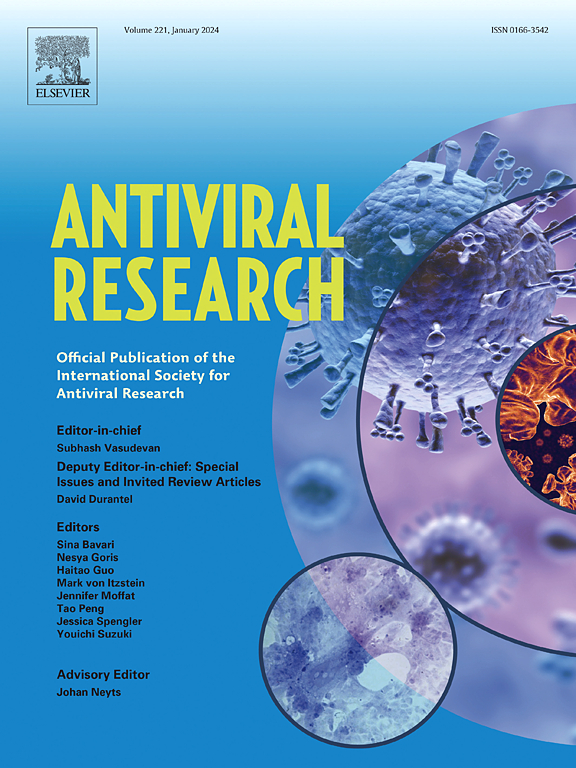Cerebrospinal fluid concentrations, viral suppression and biomarkers with long-acting cabotegravir and rilpivirine intramuscular injections
IF 4
2区 医学
Q1 PHARMACOLOGY & PHARMACY
引用次数: 0
Abstract
Our aim was to determine cerebrospinal fluid (CSF) and plasma concentrations of cabotegravir and rilpivirine (CAB/RPV) when administered as long-acting (LA) intramuscular injections every four (Q4W) or eight (Q8W) weeks, and to study the effect on viral suppression and CSF biomarkers of inflammation and neuronal injury. We included six adults with HIV receiving LA CAB/RPV Q4W or Q8W. CSF and plasma concentrations of CAB/RPV (15 samples) were analyzed by UHPLC-MS/MS. We also measured CSF and plasma HIV RNA, CSF and serum neopterin, CSF and serum β2-microglubulin, IgG index, albumin ratio, and CSF NfL. Median (range) total plasma cabotegravir concentrations were 1375 (963–2422) ng/mL, and in CSF 3.48 (1.47–7.60 ng/mL). For rilpivirine, concentrations were 93 (40–157) ng/mL and 1.21 (0.55–1.67) ng/mL, respectively. All participants hade CSF and plasma HIV RNA <20 copies/mL on every occasion. There were no significant changes in any of the CSF biomarkers in participants after switching to LA CAB/RPV. The combination of LA CAB/RPV can achieve therapeutic CSF concentrations throughout the dosing intervals and may suppress HIV replication in the CNS. No significant changes in CSF biomarkers of inflammation or neuronal injury were observed, indicating a neutral CNS effect.
长效卡博特重力韦和利匹韦林肌肉注射的脑脊液浓度、病毒抑制和生物标志物。
我们的目的是测定cabotegravir和rilpivirine (CAB/RPV)作为长效(LA)肌肉注射每4周(Q4W)或8周(Q8W)给药时脑脊液(CSF)和血浆浓度,并研究对病毒抑制和脑脊液生物标志物炎症和神经元损伤的影响。我们纳入了6名接受LA CAB/RPV Q4W或Q8W治疗的成年HIV感染者。采用UHPLC-MS/MS对15例患者的脑脊液和血浆CAB/RPV浓度进行分析。同时测定脑脊液和血浆HIV RNA、脑脊液和血清neopterin、脑脊液和血清ß2-微球蛋白、IgG指数、白蛋白比值、脑脊液NfL。中位(范围)血浆cabote重力韦总浓度为1375 (963-2422)ng/mL, CSF中为3.48 (1.47-7.60 ng/mL)。利匹韦林的浓度分别为93 (40-157)ng/mL和1.21 (0.55-1.67)ng/mL。所有参与者每次都有CSF和血浆HIV RNA < 20拷贝/mL。转换到LA CAB/RPV后,参与者的任何CSF生物标志物均无显著变化。LA CAB/RPV联合使用可以在整个给药间隔内达到治疗性CSF浓度,并可能抑制HIV在中枢神经系统中的复制。脑脊液炎症或神经元损伤的生物标志物未见明显变化,表明中性中枢神经系统效应。
本文章由计算机程序翻译,如有差异,请以英文原文为准。
求助全文
约1分钟内获得全文
求助全文
来源期刊

Antiviral research
医学-病毒学
CiteScore
17.10
自引率
3.90%
发文量
157
审稿时长
34 days
期刊介绍:
Antiviral Research is a journal that focuses on various aspects of controlling viral infections in both humans and animals. It is a platform for publishing research reports, short communications, review articles, and commentaries. The journal covers a wide range of topics including antiviral drugs, antibodies, and host-response modifiers. These topics encompass their synthesis, in vitro and in vivo testing, as well as mechanisms of action. Additionally, the journal also publishes studies on the development of new or improved vaccines against viral infections in humans. It delves into assessing the safety of drugs and vaccines, tracking the evolution of drug or vaccine-resistant viruses, and developing effective countermeasures. Another area of interest includes the identification and validation of new drug targets. The journal further explores laboratory animal models of viral diseases, investigates the pathogenesis of viral diseases, and examines the mechanisms by which viruses avoid host immune responses.
 求助内容:
求助内容: 应助结果提醒方式:
应助结果提醒方式:


